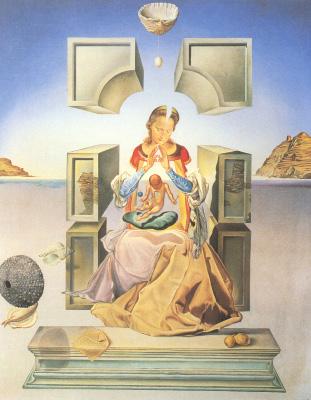
3 minute read
Magritte and Dalí

The Magritte Museum decided to celebrate its 10th anniversary last year with an incredible exhibition. It had more than 100 paintings, sculptures, photo- graphs, drawings, films and archival pieces, talking about numbers, we can mention that in January it re- ached more than 1,000,000 visitors. The festivity was really great!
Advertisement
Artnatic went to the exposition to check it out and - supported by the museum - to bring you a little of what that exhibition represents in the Belgian capital.
les amants 54cm x 73cm, 1928, oil painting, MOMA NY, (borrowed for the museum's birthday exhibition)

René Magritte was a famous painter who practically needed no introduction. He is known until nowadays as a surrealist painter and his most famous phrase is CECI N’EST PAS UNE PIPE.
He had the ability to transpose to painting the real picture of a certain time of his native country very well: Contrasts, indirect lights, sober colours, but a lot of creativity, a unique way of telling things. He knew how to use all the academic painting technique and place everyday objects as protagonists of a plot (not as a dead nature) like nobody else did.
And on this birthday idea, we think the museum had a party with a friend. A very special guest, Dali.
Thinking about a friendship between a well-behaved restrained Belgian and an eccentric Spanish is something surprising, but they were really close friends. And, of course, there was also a lot of jealousy, projects, conflict, but mutual admiration always prevailed.
Salvador Dalí and René Magritte met in Paris, in the spring of 1929, and they had common friends who were no less talented, all avangardists. During the summer of the same year, Dali invited Magritte to go to Cadaqués, a place that was very important for the Spanish painter. At that point, Eluard, Miro and Buñuel were certainly the basis of fellowship which, later on, became a new artistic movement that emerged from there.
In the cube they placed for visitors to admire the projections with the universes that were confused between the works known to one and the other, the visitor wanted to stay there for a long time. The clouds, the instruments, other objects appeared and capsule for time travail / travel memories in imaginary lands
disappeared and the desire was to know if behind any of the clouds they would be still talking there... They were unique, and while the Catalan declared: “The only difference between a madman and me is that the madman thinks he is not, but I know that I am.” And the Belgian who said: „I long for a living, impossible or ambiguous love. I am afraid to know exactly what my limitations are”.
In the cube they placed for visitors to admire the projections with the universes that were confused between the works known to one and the other, the visitor wanted to stay there for a long time. The clouds, the instruments, other objects appeared and disappeared and the desire was to know if behind any of the clouds they would be still talking there...
They were unique, and while the Catalan declared: “The only difference between a madman and me is that the madman thinks he is not, but I know that I am.” And the Belgian who said: „I long for a living, impossible or ambiguous love. I am afraid to know exactly what my limitations are”.

Artnatic went to the exposition to check it out and - supported by the museum - to bring you a little of what that exhibition represents in the Belgian capital.
The Magritte Museum decided to celebrate its 10th anniversary last year with an incredible exhibition. It had more than 100 paintings, sculptures, photographs, drawings, films and archival pieces, talking about numbers, we can mention that in January it reached more than 1,000,000 visitors. The festivity was really great!










